Best printers for T-shirts of 2024
Find the best printers for T-shirts and creating bespoke garments
The best printers for T-shirts let you create your own bespoke garments without relying on third-party businesses or investing in a DTF or DTG printer.
If you're been inspired to create your own bespoke T-shirts, there are a number of options available to make them. Many use third-party companies with heavy-duty T-shirt printers and screen-printing facilities. It’s an especially popular choice when you need bulk orders or highly accurate, high-resolution images on T-shirts and other garments. Alternatively, you can also get your own Direct to Fabric or Direct to Garment printer - although this can prove expensive, particularly for limited-run prints.
Instead, most home or small business setups choose a dedicated inkjet or laser printer which is compatible with transfer paper specifically designed for heat transfer applications. Once the design is printed onto the transfer paper, it can be heat pressed onto the T-shirt, allowing the design to transfer and bond with the fabric.
Generally speaking, all the best printers support heat transfer but how do you choose the very best printers for T-shirts? Well, we’ve put the devices to the test. During our rigorous testing and review process, we’ve assessed the top T-shirt printers when it comes to speed, accuracy, and value for money.
The best printer for T-shirts of 2025 in full:
Why you can trust TechRadar
Best printer for T-shirts overall
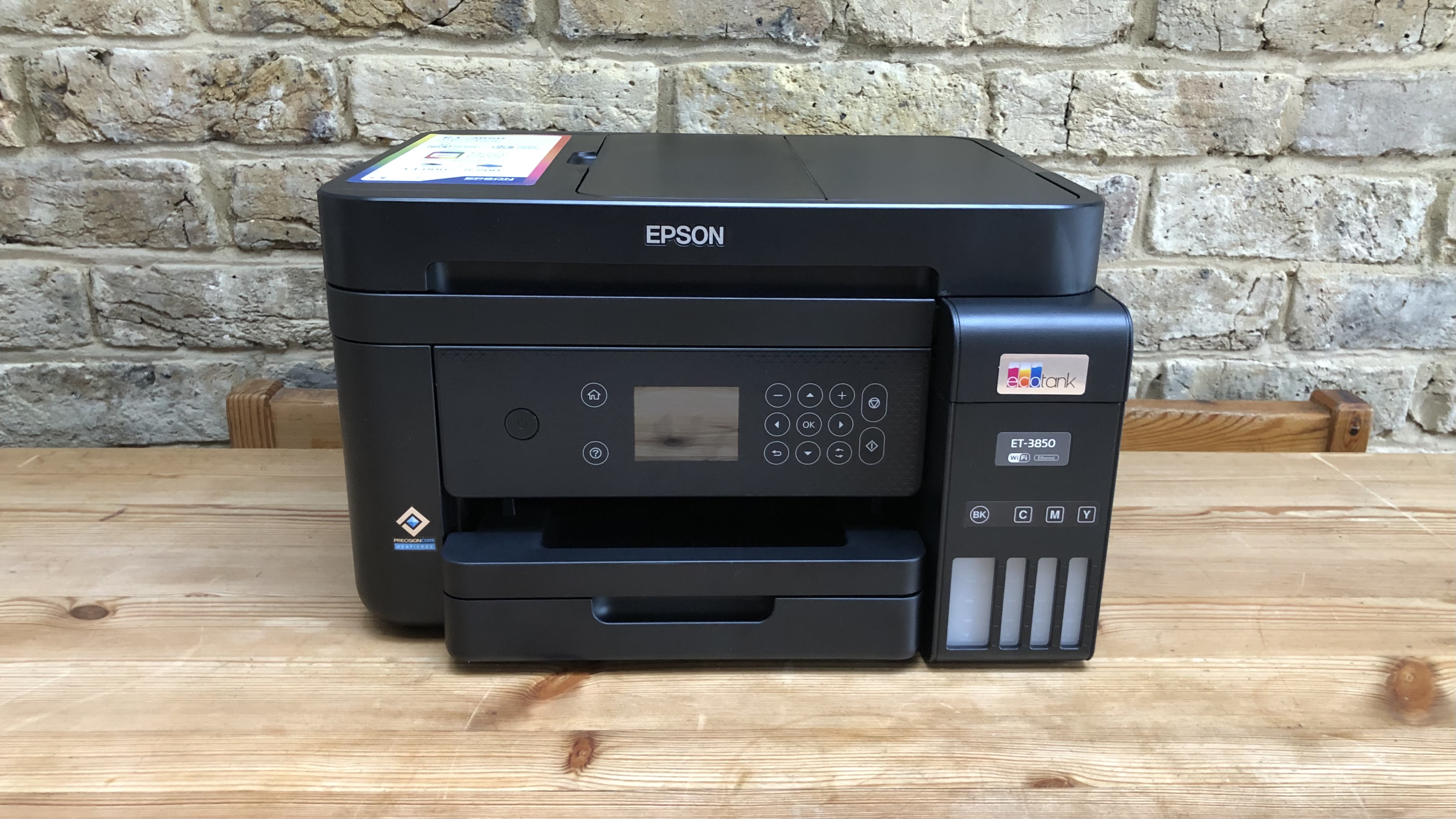
Specifications
Reasons to buy
Reasons to avoid
The 'EcoTank' range of Epson printers has a very simple premise : they provide a lot of printer ink the box, available in bottles. In our original review of this all-in-one printer we found that the supplied ink was enough to print 14,000 black and white pages, or 5,200 color, equivalent to around 70 regular print cartridges.
Replacement bottles are also inexpensive to buy. This goes a long way towards justifying the higher price tag for this EcoTank model relative to other all-in-one printers, especially as creating T-shirts can consume large amounts of ink.
The EcoTank is specifically designed for heat transfer printing. It contains an ADF (Auto Document Feeder), meaning it can handle multiple heat transfer sheets (up to 250 at a time). Its top speed is rated at 15 ppm (pages per minute) which isn't very impressive compared to its competitors but the image quality is excellent, which is most important when creating your own T-shirt design.
From doing online research we also discovered that it's relatively easy to convert your EcoTank into a "sublimation" printer, through adding specialist inks. This can result in better image quality but remember sublimation only works on polyester, whilst heat transfer works on all kinds of fabric.
The only real downside to this printer is some corners have been cut : the screen is clear and easy to use but you have to navigate it using the printer buttons. This can make entering WiFi passwords very impractical given there's no onscreen keyboard. Luckily you can also use the companion app 'Epson Smart Panel' to connect the EcoTank to your home wireless network.
Read our full Epson EcoTank ET-3850 review .
Best photo printer for T-shirts
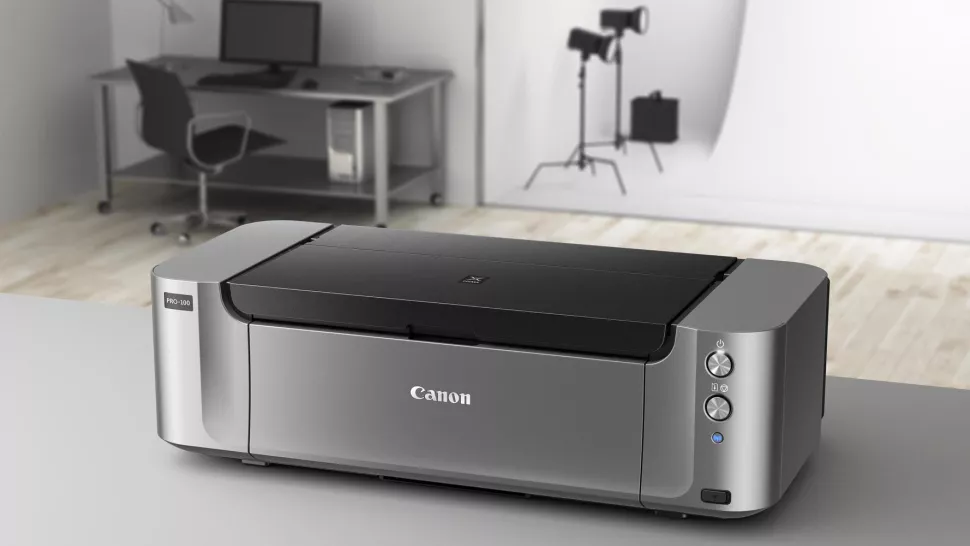
Specifications
Reasons to buy
Reasons to avoid
Canon first released the Pro model in 2012, designed specifically for printing high-quality photos. It achieves this through an 8-ink dye based system which results in professional quality prints.
There are two paper trays though - one for photo papers and a manual feed. Most importantly for your T-shirt projects, it supports printing to both transfer paper and printable vinyl on sheets of up to 13 inches x 19 inches (33cm x 48.26cm).
Besides supporting print via WiFi & USB the PRO-100S also can print directly from cloud-based and online photo storage services such Facebook, Dropbox, Google Drive and OneDrive via PIXMA Cloud Link.
As a premium printer, the Pro-100S is designed for quality not speed. Still, if it can produce one borderless 6" x 4" photo in just 34 seconds, that bodes well for running off multiple quality heat transfers.
This model has actually been superseded by the Canon Pixma Pro-200, which offers higher image quality but availability is not as good.
The only real drawback to this printer is the very high price you have to pay in order to have this kind of print quality. Still, it might be a good investment if you like to print photos as well as T-shirts.
Read our full Canon Pixma Pro-100S review .
Best for printing T-shirts fast
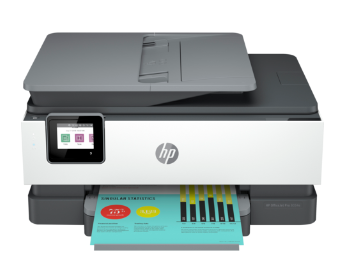
3. HP OfficeJet Pro 8034e
Specifications
Reasons to buy
Reasons to avoid
If you like to keep your printing simple then the HP Officejet Pro 8034e might be for you. This inexpensive printer can churn out pages at an astonishing rate (up to 20 per minute for black and white). Of course this speed may vary if you're printing high-res T-shirt designs onto specialist paper.
You also have the option to sign up to HP's "Instant Ink" service, which means the device will tell HP when you're running low on ink and automatically order more cartridges for you. The cost includes shipping and recycling of old cartridges.
You're automatically given a 6 month subscription to Instant Ink if you buy direct from HP - strangely the listing on Amazon shows this to be one year, so it may be best to check with the retailer directly before buying.
After checking the HP website, we were able to confirm that the 8030 series of OfficeJet Pro do support heat transfer printing. The official HP website even has a helpful guide on how to do this.
You can also use the HP+ Smart App to scan/print your T-shirt designs from anywhere. The printer also includes "self-healing" WiFi, which seemingly automatically diagnoses and fixes connection issues. If you prefer peace of mind, you can also plug into the 8034e directly via USB or Ethernet cable.
As convenient as the Instant Ink program is, you can still install cartridges yourself but HP warns the printers are only designed to be compatible with their own, not those manufactured by third-parties and will seek to block cartridges using non-HP chips or circuitry.
The website also warns that HP iron-on transfers for inkjet printers cannot be used with LaserJet printers, or with copy machines and inkjet printers that have a heating element. These products can melt the transfer and cause damage to the hardware.
Best mono laser T-shirt printer
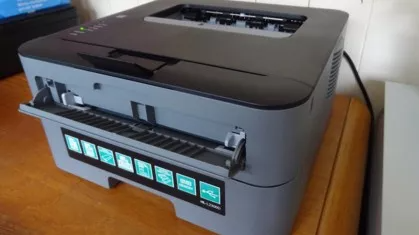
Specifications
Reasons to buy
Reasons to avoid
This small, reliable laserjet printer is perfect for your home or small business. If you can get over the fact there's no wireless printing (USB 2.0 only), you'll start to see some of the benefits of using this device to run off your heat transfers.
This printer is fast. It can run off up to 30 sheets a minute and even has a dedicated "straight through paper path." In plain English this means a manual feed slot and rear paper exit so you can easily check on designs as they print. The paper tray can take up to 250 sheets, so this is definitely one for mass T-shirt production. This capacity is mirrored in the "starter toner" packages which in theory contains enough for 250 pages, though you may find your T-shirt designs are more thirsty.
Even taking into account the sharper images produced relative to inkjet printers, quality is still excellent with a resolution of up to 2400 x 600 dpi.
For a laser printer, this is also excellent value for money. It's only really let down by the fact you can print only in black and white. Still, if you don't mind specializing in monochromatic T-shirt designs you can do much worse.
Read our full Brother HL-L2300D Mono Laser Printer review
Best for large formats
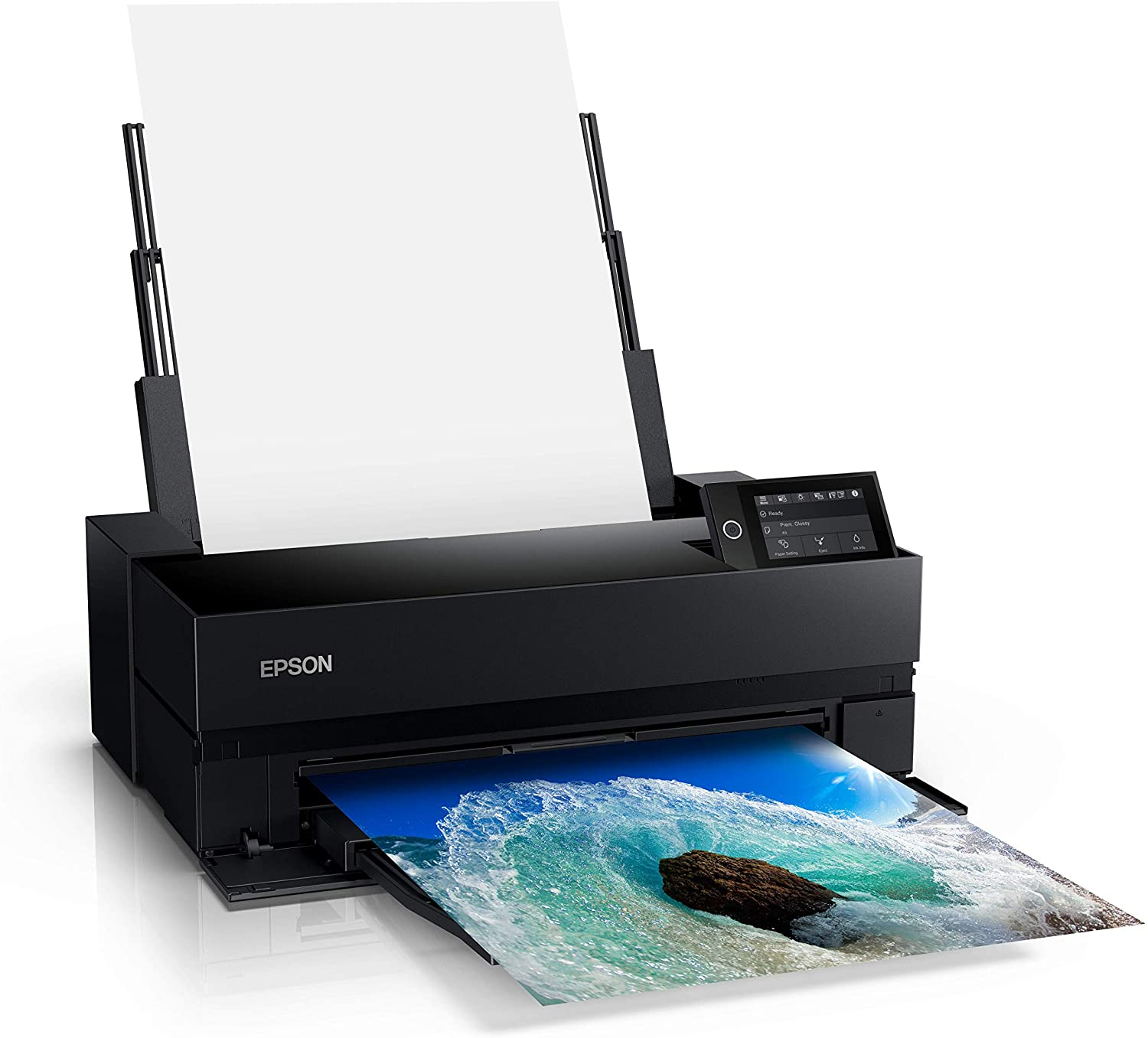
5. Epson SureColor P900 17-Inch
Specifications
Reasons to buy
Reasons to avoid
Like the P700 and P800 series before it, the P900 is designed with graphic artists in mind. This is most evident from its size, given the printer can output on pages up to 17 inches (43.18cm) wide.
Epson's website specifically states its able to print on various types of media, and it can handle media up to 1.5mm thick which should encompass nearly all types of heat transfer paper.
Departing from the usual 4 color cartridge CMYK setup the P900 comes with no fewer than 10 color cartridges. Epson describes this as: a "10-color archival pigment ink with an expanded color gamut".
In plain English this means it uses a special printhead with a number of nozzles, each capable of shooting out ink droplets of three varying sizes. The printer also has separate channels for both photo and matte black ink, which can make for a much sharper picture. The "Carbon Black technology" can make for much deeper shades of black, particularly when using heat transfer paper for T-shirt designs.
Of course having 10 cartridges, each of which can be used for varying amounts by differing print jobs means there's a cost in terms of speed. Larger photos can take up to two minutes to print fully but naturally speeds for running off T-shirt designs may be slower.
The only real question remains whether you can justify the hefty price for having such high print-quality for your T-shirts.
Best printer for T-shirts: FAQs
Can I print T-shirts with any printer?
In theory you could try to insert heat transfer paper into any inkjet or laserjet printer, then hope for the best. In practice it's best to use a printer which the manufacturer has confirmed is specifically compatible with "heat transfer" paper. Bonus points if the manufacturer can recommend a specific print medium for their printer.
Is it expensive to print T-shirts?
If you're planning to run off hundreds of T-shirts, you need to be prepared to pay for ink. We suggest doing a small test run first to make sure you're happy with the T-shirt design and quality before going into mass production. Some companies like Epson and Brother also offer reduced priced ink/ink subscriptions. For more heavyweight machinery and larger print runs, look for the best sublimation printers - they can be more expensive, but suitable for dedicated T-shirt printing.
Where can I find heat paper for printing?
Popular online retailers like Avery or Amazon stock all kinds of heat transfer paper for printing. These vary in terms of the kind of fabric for which they're designed, thickness and printer compatibility. Always check with your printer manufacturer before buying to make sure your media is compatible.
Which printer is best for T-shirts?
Some printers listed here such as the Epson SureColor P900 are best suited to producing small numbers of high-quality designs. If you're on a mission to print monochromatic T-shirt designs for everyone in your class, you may prefer to save time and money with a printer model designed for mass production such as the Brother HL-L2320D.
Whichever type of printer you choose, remember that results will vary based on the capabilities of your printer, your chosen image and the type of media on which you want to print.
If you don't get the results you need right away, make sure to check the application settings for your printer to see if there's a specific mode for heat transfer paper. This will optimize it for the task. Don't be afraid to experiment with different types of media for printing your designs either.
How to choose the best T-shirt printers
If you're deciding which printer for T-shirts is best, there are some broad categories to consider:
Inkjet vs. laser
This is one of the most important decisions you can make. Inkjet printers usually involve less upfront cost but ink can become expensive if you're producing large numbers of designs. Laser printers can be more expensive but generally produce sharper looking images.
Cartridge array
You can get some excellent results with the regular 4-color CMYK setup of cartridges but the very best printers may use extra cartridges to deliver the very best quality images. You should also pay attention to how you load more ink : for instance the Epson EcoTank involves loading bottles of ink into a series of reservoirs.
Image quality
When it comes to printing onto heat transfer paper, the DPI (dots per inch) of a printer is as crucial as the variety of colors available. In the nature of things since you're using heat to transfer the image onto fabric, the higher the quality is before being transferred to the T-shirt the more likely you are to be satisfied with the results. Check the printer manufacturer's website for the full technical specs of your chosen device.
Easy loading
If you're producing multiple T-shirt designs, an auto-document feeder can help speed things up considerably. Your printer should also be able to accommodate different thicknesses of paper depending on the material you want to use, such as extra-thick heat transfer paper or vinyl paper.
Budget
If price is no object, there are some premium printers out there which can run off designs for you with precision detail using all hues of the rainbow. Most people have to be a little more realistic but remember: generally speaking the higher the upfront cost of the printer, the less you'll have to pay for ink down the line. If you're going to make lots of T-Shirts, make sure to check how much ink will cost you, otherwise a budget printer could be a false economy.
How we test the best printers for T-shirts
We've tested hundreds of printers for home, office, and studio. This includes the best all-in-one printers, best label printers, and the best small business printers.
Whether we're testing for the best T-shirt printers or any other task, we assess a range of factors, from print speeds to print quality, as well as looking at value-for-money across both the device itself and the ink cartridges.
While we typically perform detailed comparisons and analysis, timing the printing speeds in single sheet and duplex mode - it's a little different when printing T-shirts versus printing documents. Here, we also look at the fidelity of printing onto heat paper. We're chiefly looking for high-accuracy, high-resolution prints, whether you're printing text or images.
When testing print quality, we always print the same test documents for an accurate overview across all printers. This document includes text in different font sizes and colors, as well as images. We also test patterns, evaluating sharpness and color fidelity.
Finally, we calculate running costs, and compare the interface, design, and build quality to others in the same category and use-case.
Find our more about how we test, review, and rate printers on TechRadar Pro
Get in touch
- Want to find out about commercial or marketing opportunities? Click here
- Out of date info, errors, complaints or broken links? Give us a nudge
- Got a suggestion for a product or service provider? Message us directly
- You've reached the end of the page. Jump back up to the top ^
Are you a pro? Subscribe to our newsletter
Sign up to the TechRadar Pro newsletter to get all the top news, opinion, features and guidance your business needs to succeed!
Nate Drake is a tech journalist specializing in cybersecurity and retro tech. He broke out from his cubicle at Apple 6 years ago and now spends his days sipping Earl Grey tea & writing elegant copy.